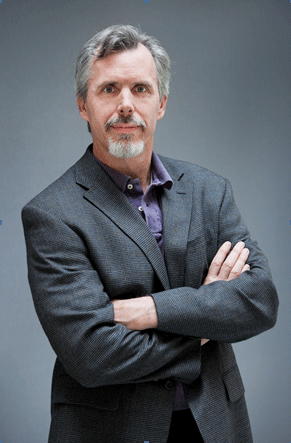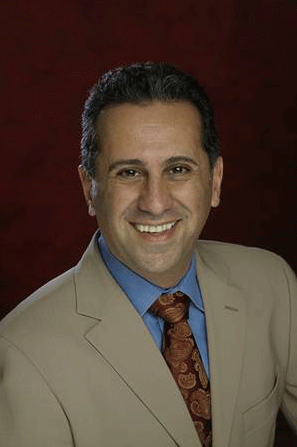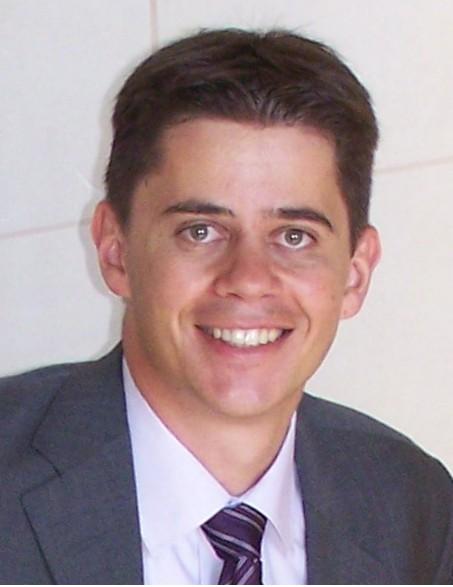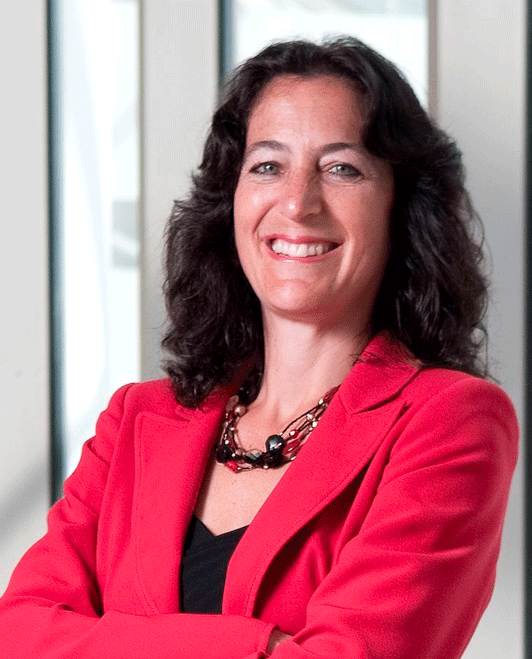Keynote Speakers
Monday Morning 2 April 2012
Green Wireless Networks
Dr. Gee Rittenhouse, Chairman of the Board, GreenTouch
WCNC 2012 keynote presentation to download
 Abstract : As wireless data access demand continues to explode, the need to build out network capacity and minimize operational expense is critical. One of the largest continued expenses is energy costs. Recent analysis has shown that an improvement of a factor of 10,000 in network energy efficiency is possible. This presentation will describe some of the recent research results and technologies necessary to achieve these gains.
Abstract : As wireless data access demand continues to explode, the need to build out network capacity and minimize operational expense is critical. One of the largest continued expenses is energy costs. Recent analysis has shown that an improvement of a factor of 10,000 in network energy efficiency is possible. This presentation will describe some of the recent research results and technologies necessary to achieve these gains.
Speaker Biography :
Gee Rittenhouse is the Chief Operating Officer of Alcatel-Lucent’s Software, Services, and Solutions Group (S3G). The S3G organization works with global operators to transform their business by creating new revenue generating opportunities in areas ranging from Cloud to applications such as mobile commerce and digital music as well as solutions that focus on customer experience. These solutions are backed by a team of services experts who deliver everything from concept planning through full-scale operations support to meet complex customer needs.
Before his current role in the S3G organization, Gee was Vice President of Bell Labs Research, overseeing all Alcatel-Lucent research in physics, computer science, mathematics, optics, access, networking, and applications. Prior to leading research he was Vice President of Bell Labs' Technology Integration Group, with the primary mission of taking Bell Labs research innovations and driving them into Alcatel-Lucent’s products and services. Before that Gee was Vice President, Bell Labs Wireless Research.
He received his Bachelor of Science degree in physics from the University of California, Los Angeles in 1986. Then in 1993 he received his Ph.D. degree in Electrical Engineering and Computer Science from the Massachusetts Institute of Technology. He joined Bell Laboratories as a member of technical staff in 1993 where he worked on high-speed circuits using X-ray lithography for optical networking applications. He later joined the Wireless Research Laboratory at Bell Laboratories where his research focused on RF front-end radio architectures and cellular system engineering. In 2000 he was promoted to Director of the Wireless Technology Research Department and led several projects including MIMO system development, cellular network optimization, wireless IP networks, and fourth generation wireless systems. In 2002 he received the Bell Labs Fellow Award. .
He is currently the Chairman of the Board of Green Touch, a non-profit pre-competitive research consortium focused on dramatic reductions in network energy requirements. He also has numerous publications and patents in the areas of communications and circuits
Networks of the Future - Some Challenges Ahead
Dr. Siavash Alamouti, Group R&D Director, Vodafone
WCNC 2012 keynote presentation to download
 Abstract : The rise in demand for fixed and mobile communications bandwidth and the increasing trend to wireless connection is well established. Since the time of Marconi, increased wireless capacity has been delivered by improved modulation and coding, use of more of the radio spectrum and decrease in average link length (more cells). Technology is getting close to the Shannon limit, though multi-site MIMO techniques can still squeeze out a little more. Spectrum is a limited resource, though more can still be made available. The biggest factor will need to come from the continued shrinking of the cell and the use of intelligent self-organizing schemes for the seamless management of end-user experience across a heterogeneous mixture of different cell types, different frequency bands, and licensed/unlicensed technologies. Even if more spectrum is made available for mobile communications, there is a big challenge in building radios capable of exploiting it, especially as neighboring frequency bands are increasingly likely to be occupied. The fixed network will also play an increasingly important role in connecting cell sites, particularly as small cell deployments start to proliferate. Fiber penetration is growing, but the economics of ubiquitous fiber make competing infrastructures hard to achieve. Means of unbundling fiber access in the same way as copper local loops are unbundled today will be important in ensuring an efficient market in fiber connectivity.
Abstract : The rise in demand for fixed and mobile communications bandwidth and the increasing trend to wireless connection is well established. Since the time of Marconi, increased wireless capacity has been delivered by improved modulation and coding, use of more of the radio spectrum and decrease in average link length (more cells). Technology is getting close to the Shannon limit, though multi-site MIMO techniques can still squeeze out a little more. Spectrum is a limited resource, though more can still be made available. The biggest factor will need to come from the continued shrinking of the cell and the use of intelligent self-organizing schemes for the seamless management of end-user experience across a heterogeneous mixture of different cell types, different frequency bands, and licensed/unlicensed technologies. Even if more spectrum is made available for mobile communications, there is a big challenge in building radios capable of exploiting it, especially as neighboring frequency bands are increasingly likely to be occupied. The fixed network will also play an increasingly important role in connecting cell sites, particularly as small cell deployments start to proliferate. Fiber penetration is growing, but the economics of ubiquitous fiber make competing infrastructures hard to achieve. Means of unbundling fiber access in the same way as copper local loops are unbundled today will be important in ensuring an efficient market in fiber connectivity.
This talk will consider the R&D challenges in creating the right type of self-organizing heterogeneous networks and the RF issues that need to be addressed in order to ensure efficient exploitation of all available spectrum. It will also consider the research challenges associated with efficient fiber unbundling, laying out the foundation for future wireless networks.
Speaker Biography : Siavash Alamouti is an Iranian-American engineer who is best known for the invention of the so-called Alamouti space–time block code,[1] filed in 1997 and patented jointly with Vahid Tarokh.[2] Alamouti's code is a 2 transmit antenna space-time block code and has been adopted in various global standards. Formerly an Intel Fellow and the CTO of Mobile Wireless Group at Intel Corp., since March 2010 he is the Group R&D Director for the global mobile operator Vodafone.[3]
In 2002, the IEEE Communications Society recognized him as the author of one of the 57 most important papers in all society's transactions during the past 50 years.
Siavash M. Alamouti received the B.S. and the M.Sc. degrees in electrical engineering from the University of British Columbia, Vancouver, Canada, in 1989 and 1991, respectively.
He was an Intel Fellow in the Mobility Group and chief technology officer of the Mobile Wireless Group, responsible for all wireless standards with a product roadmap at Intel. This includes the WiMAX Forum, IEEE 802.16, 3GPP, OMA, WiFi Alliance and IEEE 802.11. He was also known as the technical champion of WiMAX technology at Intel.
Prior to joining Intel in 2004, Alamouti worked for Vivato, Inc., Cadence Design Systems, AT&T Wireless Services and MPR Teltech Ltd. in various engineering roles.
Alamouti holds over 20 patents in the areas of wireless communication applications and wireless systems design. He has authored many publications and technical reports in the last decade for the IEEE Communications Society and other organizations that have reached professional audiences both nationally and internationally.
Tuesday Morning 3 April 2012
Embracing Heterogeneity in Wireless Networks
Dr. Thomas Sälzer, Director R&D, Huawei Technologies France
WCNC 2012 keynote presentation to download
 Abstract : Wireless connectivity has dramatically changed since the early days of voice only GSM to true mobile broadband access with HSPA+ and LTE today. An inevitable consequence of the increasing needs for capacity and wireless services is the increasing heterogeneity in wireless networks. Heterogeneity manifests itself in different dimensions such as spectrum usage, network topology, wireless technologies, services, and devices. The talk will give an overview of the heterogeneity encountered in the different dimensions and encourages several axes of research to embrace this heterogeneity in the future development of wireless networks.
Abstract : Wireless connectivity has dramatically changed since the early days of voice only GSM to true mobile broadband access with HSPA+ and LTE today. An inevitable consequence of the increasing needs for capacity and wireless services is the increasing heterogeneity in wireless networks. Heterogeneity manifests itself in different dimensions such as spectrum usage, network topology, wireless technologies, services, and devices. The talk will give an overview of the heterogeneity encountered in the different dimensions and encourages several axes of research to embrace this heterogeneity in the future development of wireless networks.
Speaker Biography : Dr. Thomas Sälzer is with Huawei Technologies since 2008. He is currently responsible for research and standardisation activities of mobile radio systems such as HSPA and LTE. Dr. Sälzer has been active in wireless research and standardisation for more than 10 years. Previously, he worked as research engineer for Mitsubishi Electric and for France Telecom / Orange Labs as senior standardisation manager for wireless access. He was involved in major European Research projects for the next generation of wireless mobile systems like 4MORE and WINNER and also has a deep experience in their standardisation through his work in 3GPP-RAN and NGMN. He is currently a leading member of 3GPP-RAN and head of delegation for Huawei Technologies. Dr. Sälzer holds degrees in electrical engineering and telecommunications from the University of Stuttgart, Germany, and Télécom ParisTech, France. He earned his Ph.D. in electrical engineering from INSA Rennes, France. Dr. Sälzer has authored and co-authored many publications in the field of wireless communications and is also co-author of the book “LTE, the UMTS longterm evolution”.
Beyond 4G: What Lies Ahead for Cellular System Design
Prof. Andrea Goldsmith, Stanford University
WCNC 2012 keynote presentation to download
 Abstract :
The demand for cellular communications has enjoyed exponential growth worldwide for decades, and looks to continue unabated into the foreseeable future. To meet these demands, the next generation of cellular networks must support a significant increase in capacity, better coverage and reliability, greater spectral efficiency, and lower energy consumption in both the infrastructure and the terminals. Overcoming these technical challenges will require significant breakthroughs in wireless hardware as well as cellular system design. This talk will describe the challenges of “Beyond 4G” cellular system design, along with recent innovations in hierarchical architectures, dynamic resource allocation, cooperative communications, smart MIMO, and “green” wireless that have the potential to overcome some of these challenges.
Abstract :
The demand for cellular communications has enjoyed exponential growth worldwide for decades, and looks to continue unabated into the foreseeable future. To meet these demands, the next generation of cellular networks must support a significant increase in capacity, better coverage and reliability, greater spectral efficiency, and lower energy consumption in both the infrastructure and the terminals. Overcoming these technical challenges will require significant breakthroughs in wireless hardware as well as cellular system design. This talk will describe the challenges of “Beyond 4G” cellular system design, along with recent innovations in hierarchical architectures, dynamic resource allocation, cooperative communications, smart MIMO, and “green” wireless that have the potential to overcome some of these challenges.
Speaker Biography :
Andrea Goldsmith is a professor of Electrical Engineering at Stanford University, and was previously an assistant professor of Electrical Engineering at Caltech. She co-founded and served as CTO for Accelera Mobile Broadband, Inc. and Quantenna Communications Inc., and has previously held industry positions at Maxim Technologies, Memorylink Corporation, and AT&T Bell Laboratories. Dr. Goldsmith is a Fellow of the IEEE and of Stanford. She has received several awards for her work, including the IEEE Communications Society and Information Theory Society joint paper award, the National Academy of Engineering Gilbreth Lecture Award, the IEEE Wireless Communications Technical Committee Recognition Award, the Alfred P. Sloan Fellowship, and the Silicon Valley/San Jose Business Journal’s Women of Influence Award. She currently serves on the Steering Committee for the Transactions on Wireless Communications, and as Editor for the Journal on Foundations and Trends in Communications and Information Theory and in Networks. She was previously an editor for the IEEE Transactions on Information Theory, the IEEE Transactions on Communications, and for the IEEE Wireless Communications Magazine. Dr. Goldsmith has served on the Board of Governors and as a Distinguished Lecturer for both the IEEE Information Theory and Communications Societies. She also served as President of the Information Theory Society in 2009, founded and chaired its Student Committee, and currently chairs the IEEE Communications Society Emerging Technology Committee. At Stanford she received the inaugural University Postdoc Mentoring Award, served as Chair of its Faculty Senate, and currently serves on the Faculty Senate and the Budget Group. Dr. Goldsmith has authored the book ``Wireless Communications'' and co-authored the books ``MIMO Wireless Communications'' and ““Principles of Cognitive Radio,” all published by Cambridge University Press. Her research includes work on wireless information and communication theory, wireless network design, cognitive radios, sensor networks, smart grid design, and applications of communications and signal processing to biology and neuroscience.